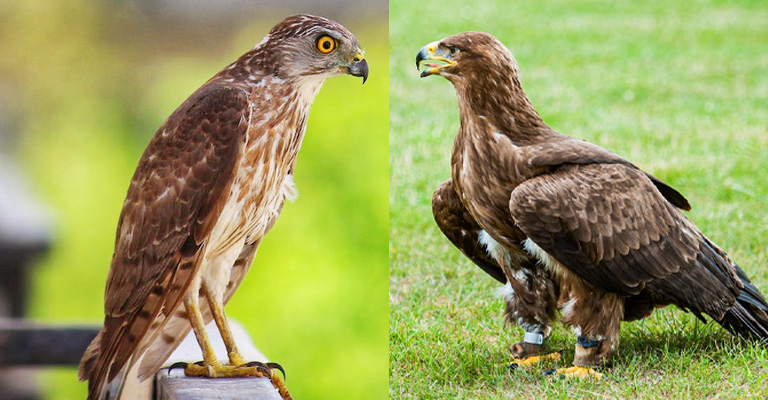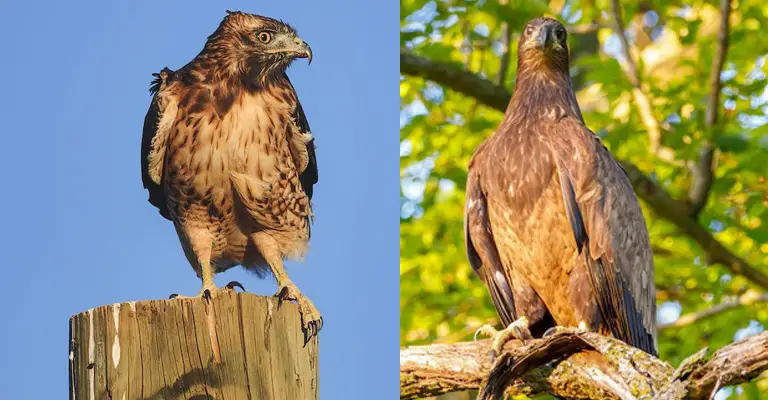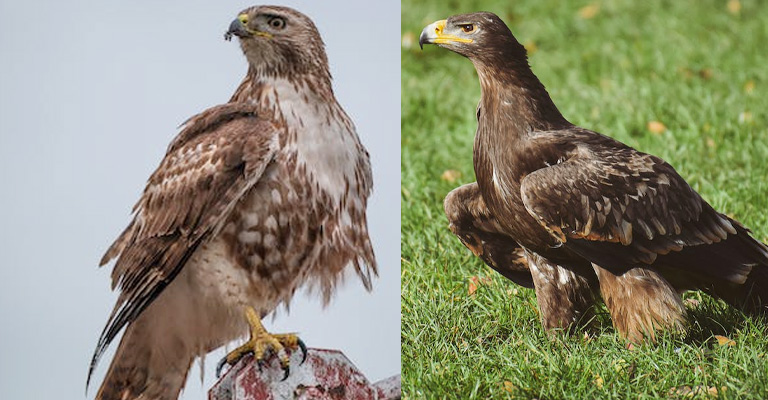The skies become arenas of epic battles when the Red-tailed Hawk and the Golden Eagle take flight. These majestic raptors, with their powerful wingspans and razor-sharp talons, command respect in the avian world.
In this article, we delve into the fascinating comparison between the Red-tailed Hawk and the Golden Eagle, two formidable predators known for their exceptional hunting skills and dominance in their respective habitats.
From their physical attributes and hunting techniques to their preferred prey and unique behaviors, we explore the distinct characteristics that set these magnificent birds apart and shed light on the awe-inspiring encounters that unfold in the realm of the feathered hunters of the sky.

Appearance and Size: Red Tailed Hawk Vs Golden Eagle
The first thing you need to check while differentiating a Red-Tailed Hawk and a Golden Eagle is their size and appearance. Here are the facts you need to check.
Red-tailed Hawk’s Appearance
Red-tailed hawks (Buteo jamaicensis) exhibit notable characteristics that aid in their identification. They possess a wingspan ranging from 4 to 6 feet, making them medium-sized birds.
In terms of body weight, red-tailed hawks typically weigh up to 2.5 pounds. Their plumage displays a combination of brown hues on the upper parts, while the underside often features a pale coloration with a distinct belly band.
However, the most distinguishable feature of the red-tailed hawk is its vibrant red tail, visible during flight, and is a reliable identifier.
Golden Eagle’s Appearance
In contrast to red-tailed hawks, golden eagles (Aquila chrysaetos) are significantly larger birds of prey. They boast an impressive wingspan that can reach up to 8 feet, granting them excellent soaring abilities.
With a body weight of up to 10 pounds, golden eagles are substantially heavier than red-tailed hawks. Their name stems from the golden coloration present on their head and neck.
The rest of their body is adorned with dark brown plumage, accentuated by a notable pale patch at the base of their tail. These distinctive features contribute to the regal appearance of the golden eagle.
Their appearance is an essential element in their identification and adds to their awe-inspiring presence in the natural world.
Habitat and Range: Red Tailed Hawk Vs Golden Eagle

If you observe these species closely, you’ll find a lot of differences in their habitat and ranges. The following facts will help you understand the differences.
Red-tailed Hawk’s Habitat Preferences
Red-tailed hawks are remarkably adaptable birds, capable of thriving in a variety of environments. They are commonly found across North America, from open grasslands and deserts to forests and urban areas.
These versatile raptors can adapt their hunting strategies to suit different habitats, making them a familiar sight in diverse landscapes. Red-tailed hawks can be observed perched on utility poles, gliding above open fields, or soaring high in the sky, showcasing their adaptability and resilience.
Golden Eagle’s Habitat Preferences
Golden eagles have distinct preferences for open habitats, particularly those characterized by mountains, cliffs, and wide expanses of grassland. These birds are often associated with rugged terrains and expansive wilderness.
They can be found in various parts of the world, including North America, Europe, Asia, and even parts of northern Africa. Golden eagles’ habitat preferences reflect their hunting style, as open landscapes provide them with clear visibility and ample opportunities to spot and pursue prey.
Their global distribution highlights their adaptability to a range of environments. Appreciating their habitat preferences enhances our understanding of these majestic raptors and their role within their respective ecosystems.
Behavior and Hunting Strategies

For sure, Red Tailed Hawk and Golden Eagle don’t share the same strategies in their behavior and hunting system. Here are the areas where they have differences.
Red-tailed Hawk’s Hunting Behavior
Red-tailed hawks exhibit specific hunting behaviors tailored to their prey preferences. They primarily target small mammals such as mice, rabbits, and squirrels.
These birds of prey employ a combination of keen eyesight and patient observation to locate potential prey. Red-tailed hawks are adept at soaring high in the sky, scanning the ground below for movement.
Once a suitable target is identified, they employ a remarkable hunting technique by soaring or gliding and then diving swiftly toward their prey.
This diving approach allows them to surprise and capture their prey efficiently, utilizing their sharp talons for a secure grip.
Golden Eagle’s Hunting Behavior
Golden eagles are versatile predators known for their wide range of prey selection. They exhibit remarkable adaptability and can hunt various small to medium-sized mammals, birds, reptiles, and even carrion.
Golden eagles often employ two primary hunting techniques. Firstly, they perch on high vantage points, such as cliffs or tall trees, patiently scanning the surroundings for potential prey.
Once a target is spotted, they employ a swift and precise aerial attack, swooping down to seize their prey with their powerful talons.
Secondly, golden eagles can also be seen soaring and gliding over their territory, using their exceptional eyesight to spot prey from great distances.
Their agility and strength enable them to take down larger prey, such as foxes or young deer, showcasing their predatory prowess.
The distinct hunting behaviors of red-tailed hawks and golden eagles highlight their adaptations to different prey sources and habitats. Red-tailed hawks excel in their aerial hunting technique, utilizing their diving abilities to capture smaller prey.
Golden eagles, on the other hand, exhibit versatility in prey selection and employ a combination of perching, aerial attacks, and the ability to tackle larger prey.
These behaviors exemplify the remarkable hunting strategies employed by these magnificent raptors in their pursuit of survival.
Conservation Status: Red Tailed Hawk Vs Golden Eagle

You need to compare the conservation status of these two bird groups to identify them as well. Please check the following points to compare them in this context.
Red-tailed Hawk’s Conservation Status
Red-tailed hawks are considered a species of least concern in North America. This designation indicates that their population is relatively stable and not currently at significant risk.
Several factors contribute to their stable population status. Firstly, red-tailed hawks exhibit adaptability to a wide range of habitats, allowing them to thrive in diverse environments.
Additionally, their opportunistic feeding habits and ability to adjust their hunting strategies contribute to their success.
Red-tailed hawks have also benefited from protected habitats, such as national parks and conservation areas, which provide them with suitable nesting sites and prey resources.
Golden Eagle’s Conservation Status
Globally, the golden eagle is also considered a species of least concern. However, it is important to note that while the species as a whole is not currently at significant risk, local threats and declines have been observed in specific areas.
Factors contributing to the local decline of golden eagles include habitat loss, disturbance, and persecution.
Human activities, such as deforestation, land development, and disturbance of nesting sites, can disrupt golden eagles’ breeding and foraging habitats.
Additionally, persecution through illegal hunting or poisoning poses a threat to golden eagles in certain regions.
Although the species, as a whole, maintains a relatively stable population globally, continued monitoring and targeted conservation efforts are essential to safeguard local populations and mitigate threats.
While red-tailed hawks enjoy a stable population in North America, efforts must continue to protect their habitats and ensure the availability of suitable prey resources.
Golden eagles, although considered a species of least concern globally, require targeted conservation measures to mitigate local threats and declines.
Red-tailed Hawk and Golden Eagle
| Aspect | Red-Tailed Hawk | Golden Eagle |
| Wingspan | 4-6 feet | Up to 8 feet |
| Body Weight | Up to 2.5 pounds | Up to 10 pounds |
| Plumage Colors | Brown upperparts, the pale underside with a belly band | Dark brown body, golden head, and neck feathers |
| Tail Coloration | Red | Pale patch at the base of the tail |
| Habitat Preferences | Adaptable to various environments: forests, grasslands, deserts, urban areas | Open habitats: mountains, cliffs, grasslands |
| Global Distribution | North America | North America, Europe, Asia, parts of northern Africa |
| Prey Preferences | Small mammals (mice, rabbits, squirrels) | Small to medium-sized mammals, birds, reptiles, carrion |
| Hunting Techniques | Soaring, diving from high perches to capture prey | Perching, aerial attacks, hunting from high vantage points |
| Conservation Status | Least concern in North America, the stable population | Least concern globally, local threats and declines in specific areas |
FAQs
Red-tailed hawks typically build large nests made of sticks, usually placed in the branches of tall trees. They may reuse and expand their nests in subsequent years.
Golden eagles, on the other hand, prefer nesting on cliffs or rocky ledges. They construct large nests made of sticks and line them with softer materials such as grass or moss.
Golden eagles tend to choose more remote and inaccessible locations for their nests.
Red-tailed hawks are generally non-migratory birds, meaning they tend to stay in their breeding territories year-round. However, some populations of red-tailed hawks do undertake short-distance migrations, particularly in response to changes in food availability or harsh weather conditions.
Golden eagles, on the other hand, are known for their long-distance migratory behavior. They typically migrate to different regions for breeding and wintering, often traveling significant distances.
Red-tailed hawks and golden eagles can share overlapping habitats and occasionally interact with each other. However, their interactions are usually competitive in nature.
Golden eagles are larger and more powerful, which can intimidate red-tailed hawks and potentially displace them from their hunting territories. Red-tailed hawks may exhibit defensive behaviors when golden eagles are in the vicinity, such as vocalizing or dive-bombing them to protect their nests or prey.
Both red-tailed hawks and golden eagles are protected under various conservation laws in many countries. In the United States, for example, they are protected by the Migratory Bird Treaty Act and the Bald and Golden Eagle Protection Act.
These laws prohibit the possession, hunting, and disturbance of these birds, their nests, and eggs. The protection helps ensure their populations remain stable and safeguard their habitats from harmful activities.
Conclusion
The Red-tailed Hawk and the Golden Eagle are both formidable raptors, each with its unique strengths and characteristics.
While the Red-tailed Hawk impresses with its versatility, adaptability, and hunting prowess, the Golden Eagle commands awe with its immense size, strength, and powerful flight.
Although both birds of prey occupy similar habitats and share a carnivorous diet, they differ in size, hunting techniques, and preferred prey.
Despite occasional clashes over territory and resources, their coexistence highlights the remarkable diversity of nature’s avian predators.
Hopefully, you’ve got my point on the differences between these two beautiful species. Thank you for your time.